|
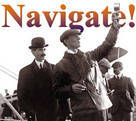
 Up
Up 
 An Inkling
An Inkling
of an Idea 
(You are here.)
 Down
Down




  Need
to Need
to
find your
bearings?
Try
these
navigation aids:
If
this is your first
visit, please stop by:
Something
to share?
Please:



|
|
Available in Française, Español, Português, Deutsch, Россию,
中文,
日本, and others.
 uch
of this aviation news was lost on Orville. He also missed Dayton's
centennial celebration on 14 September 1896 and never saw the float
he had worked on. In late August, he contracted a deadly case of
typhoid and his fever soured as high as 105° F (40.5° C). His sister
Katharine was bound for her junior year at Oberlin College, but she
stayed home to help Wilbur nurse Orville through the delirium that
followed. While holding vigil at Orville's sickbed, Wilbur happened
to read an account of
Otto Lillienthal's death in a newspaper. uch
of this aviation news was lost on Orville. He also missed Dayton's
centennial celebration on 14 September 1896 and never saw the float
he had worked on. In late August, he contracted a deadly case of
typhoid and his fever soured as high as 105° F (40.5° C). His sister
Katharine was bound for her junior year at Oberlin College, but she
stayed home to help Wilbur nurse Orville through the delirium that
followed. While holding vigil at Orville's sickbed, Wilbur happened
to read an account of
Otto Lillienthal's death in a newspaper.
Both the Wright
brothers were well aware of the "Flying Man." They had followed the experiments of Otto Lilienthal since 1890 when they
plucked a news item off their wire service and rewrote it as a humorous piece for
The
Evening Item.
"A German named Lilienthal, after experimenting for 23 years with artificial
wings, has succeeded in raising himself, weight 160 pounds, with the aid of a
counterweight, lifting 80 pounds. How to raise the other 80 pounds is still beyond
him."
Lilienthal’s death, according to Wilbur, "aroused a passive interest which
had existed from my childhood, and led me to take down for the shelves of our home library
a book on Animal Mechanism by Prof. Marey, which I had already read several
times." Wilbur already had the inkling of an idea. He guessed – correctly –
that Lilienthal had died because he could not adequately control his glider. Lilienthal,
in fact, had no controls other than weight-shifting. He hung beneath the aircraft and threw his legs this way and
that, shifting his body weight to keep it balanced. Wilbur also guessed that nature must
have provided birds with a better method for balance and control, but he didn’t find
it in Marey’s book.
Concentrated on Control
Orville's fever broke in early October and Wilbur filled him in
on the news concerning Lilienthal. Orville agreed that the problem
seemed to be control. Over the next few years, the brothers
continued to discuss the problem of controlling an aircraft. There
was plenty more aviation news to keep their interest fresh. On
28 November 1896,
Samuel Langley,
Secretary of the Smithsonian Institution, launched Aerodrome No. 6 from his floating
launching platform. It flew for one minute, forty-five seconds,
covering 4800 feet (1.5 kilometers). In 1897,
Percy Pilcher of Scotland made a record flight in a glider of
his own design, traveling 750 feet (229
meters). Also in 1897,
Augustus Herring
broke with Chanute, found a new partner in Matthias Arnot, and
returned to the dunes with an improved biplane. In 1898, Herring
mounted a compressed air motor on his glider and made a few short
unsustained hops at Silver Beach near St. Joseph, Michigan.
The Wrights could not help but notice that the common element in all
these events was a lack of control. As bicyclists, they had great
respect for control; they knew that an aircraft would never be
practical unless it could be navigated. To learn more about aerial
control, they began to observe birds
to see how they behaved in flight. At the time there was a
disagreement among ornithologists whether birds navigated by
shifting their body weight or by moving their wings. One day as
Wilbur was walking in West Dayton, a pigeon flew past. As he watched
the pigeon flying away from him, it made a series of very quick
maneuvers. These were much too fast, Wilbur thought, to have been
accomplished by shifting body weight. The only other possibility was
aerodynamic control from wing movement. Wilbur and Orville also took
long bicycle rides out the the "Pinnacles," a geologic oddity south
of town near the Great Miami River. Here they watched buzzards (turkey
vultures), huge birds that soared gracefully above the river valley.
They made two important observations. First, when the buzzards
turned in the air, they rolled their bodies right or left, much the
same way cyclists lean into a turn. Second, they somehow adjusted their
primary
feathers – the feathers at the outer trailing edges of their
wings – to initiate a roll.
Downhill for Bicycles
Their thoughts weren't just fixed on birds and aviation, however.
In 1897, the bicycle industry in the United States began a slow,
painful "shakeout." A decade before, when the safety bicycle was
introduced, demand had far outstripped supply. Prices were high,
profits were huge. This, in turn, attracted investors and
entrepreneurs who rushed to fill the demand. By 1897, the market was
oversupplied and prices began to drop. A bicycle that cost $100 a
few years earlier could now be had for $50. A few years later
department stores and other large
marketers were selling bicycles for less than
$10. Small manufacturers like the Wright Cycle Company could no
longer turn a profit on the bicycles they made. Many went out of
business. We don't know exactly when the
downturn in the industry began to affect the Wrights. As late as
1898 Orville wrote to his father that the bicycle business was good.
This might have been bravado; it's possible he didn't want the
Bishop to worry. It's also likely that the Wrights had a grace
period. Dayton was far from the centers of government and commerce
and often lagged behind in national trends. They may have also been
somewhat insulated from the falling sales of new machines because a
good bit of their business was repairs, upgrades, and sales of used
equipment. However, the shakeout was very much in the news;
Orv and Will couldn't help but be concerned. War and Sport
On 25 March 1898, as the bicycle industry continued to shrink and
America geared up for the Spanish-American War, the Assistant
Secretary of the Navy Theodore Roosevelt, at the suggestion of
Dr. Charles Walcott (then the acting Assistant Secretary of the
Smithsonian Institution) suggested to his boss, Secretary John
D. Long that a man-carrying version of a Langley Aerodrome
would have military potential. He also wrote to other members of the
Department of War, saying, "...the machine has worked. It seems to
me worthwhile for this government to try whether or not it will work
on a large enough scale to be of use in the event of war.” Two weeks later
Samuel Langley delivered a
proposal to the Department of War to provide a man-carrying flying
machine for $50,000. It was the largest amount of money the U.S.
government had ever spent for weapons research. The implications
of this were not lost on the Wright brothers. There was a living to
be made in aviation. Like most of their neighbors, they had no doubt
that Langley would produce a successful aircraft. He was, after all,
the most famous scientist in America and he had the intellectual
power of the Smithsonian behind him, not to mention the money of the
War Department. But they also knew that Langley's aerodromes could
not be navigated; there were no controls. That was where they
could make a difference. The amount of public interest in Lilienthal
and Chanute also suggested to them that flying could be another
popular recreational sport like cycling. Many years later when
Wilbur was demonstrating his Flyer in Europe, a journalist asked him
what was an airplane good for. Wilbur replied, "Why, for sport, of
course." Add My Mite
A year after Langely began work on his Great Aerodrome,
Joseph and Elizabeth Pennell, journalists who made their living
writing about their bicycle trips through Europe, commented that
1899 "...was as bad a year as the (bicycle) trade has ever seen."
The Wright brothers, like every other small bicycle manufacturer,
must have felt that their future was uncertain. Whether he was motivated by financial worries or passionate
curiosity – or both – on 30 May 1899, Wilbur wrote to the Smithsonian Institution
on Wright Cycle Company stationary asking for a list of
publications on aeronautics. "I wish to avail myself of all that is already
known," Wilbur wrote, "and then if possible add my mite to help on
the future worker who will attain final success."
|
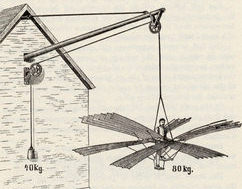
The Wrights' tongue-in-cheek news story referred to this experiment.
Lilienthal measured the lift he could generate with his first
aircraft (an ornithopter) by suspending it, flapping its wings, and
counterbalancing the pilot and machine with weights.
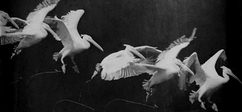
Étienne-Jules Marey, the author of
Animal Mechanism, also developed a form of high-speed
photography that he used to study the actions of animals, especially
birds. In 1890, he published
The Flight of Birds, showing many of his "chrono-photographs."
Click on the photo above to see one of these photos animated. Click
the titles above to peruse his books.
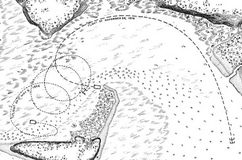
A diagram showing the best flight of
Aerodrome No. 5 in May 1896
and Aerodrome No. 6 in
November.
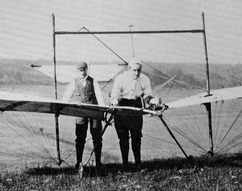
Percy Pilcher ready to launch his record-breaking glider, the
Hawk.
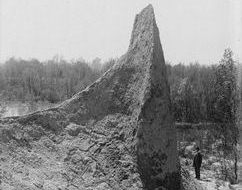
Wilbur and Orville often rode their bicycles out to the
"Pinnacles," strange geologic formations that overlooked the Great
Miami River. They were made from compacted gravel left from Ice Age
glaciers. They have since been covered by a landfill.
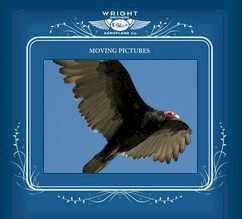
If you would like to see what Wilbur and Orville saw at the
Pinnacles, watch this short movie of a turkey vulture in flight.
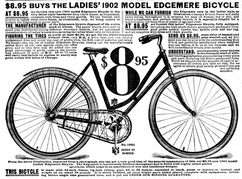
An ad from the 1902 Sears & Roebuck catalogue. With the
introduction of mass-produced bicycles into the market, prices
plummeted and small manufacturers could no longer operate
profitably.
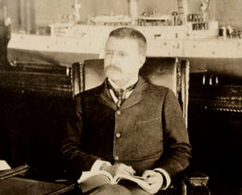
Theodore Roosevelt in 1897, then the Assistant Secretary of the
Navy. Later, he would become the first US president to fly.
|